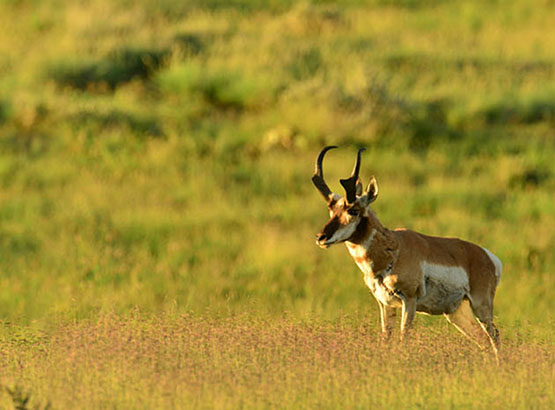Pronghorn
A conspicuous characteristic of the pronghorn is the white rump patch. When alarmed, the hair stands erect and appears as a white flash that can be seen for miles. Tan is the dominant body color, with sharply contrasting white markings on the head and neck. The top of the buck’s nose is dark and there is usually a triangular black patch below the ear.

About
Pronghorn are native to the prairies of North America. At one time they numbered in the millions and were found on the open plains from the Mississippi River to the Rocky Mountains and from Mexico to central Canada. With the European settlement of the plains, the population was reduced nearly to extinction. In Arizona, pronghorn are found primarily in the northern plains.
The name pronghorn comes from the pronged or sharply pointed horn of the males. The females’ horns are smaller and more slender. Pronghorn have true horns in that the horny tissue is composed of fused hairs which form over a bone core. Horns reach their maximum size during the summer and the sheaths are shed annually, usually in the fall.
Hunt History
After a closed season from 1944 to 1948, pronghorn hunting in Arizona recommenced in 1949. Hunts were liberalized gradually, until 1954 when 1,600 permits were issued and 1,146 bucks were taken.
Despite the issuance of a number of doe pronghorn permits between 1961 and 1975, this level of harvest has never again been equaled. Annual harvests since 1990 have varied between 500 and 700 bucks, with archers taking a proportionally larger percent of the harvest in recent years. Plagued by encroaching subdivisions, increasing highway construction, and other land-use changes, maintaining even the present number of pronghorn is dependent on citizen involvement and an aggressive translocation program. Approximately 10 percent of the pronghorn harvest is in areas having reintroduced herds.
Did you know? .. Pronghorn breed in August and September and the young are born in May and June. The gestation period for the pronghorn is the longest for big-game animals in the United States.

Our Mission
To conserve Arizona’s diverse wildlife resources and manage for safe, compatible outdoor recreation opportunities for current and future generations.
Hunt Regulations
Rules and regulations for hunting in Arizona.
Regulations for spring hunts, fall hunts and pronghorn, elk hunts.
